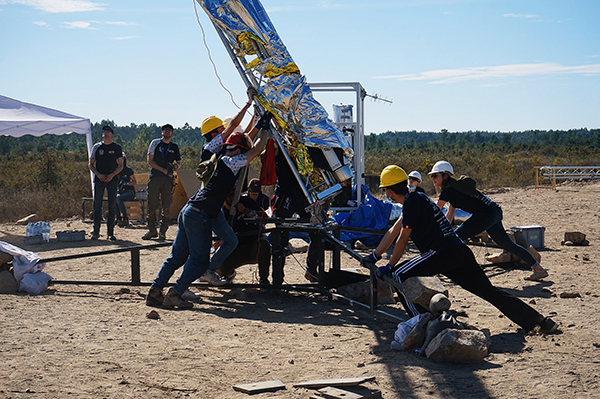 With their hybrid rocket, student project PICCARD reaches an altitude of over 6 kilometers and sets a new world record. For the construction of their winning rocket, the team relied on various 3D printing technologies such as Selective Laser Sintering. By Janek Huschke
With their hybrid rocket, student project PICCARD reaches an altitude of over 6 kilometers and sets a new world record. For the construction of their winning rocket, the team relied on various 3D printing technologies such as Selective Laser Sintering. By Janek Huschke
A maiden launch to remember
The European Rocketry Challenge EUROC in Portugal last October. In the desert-like landscape a speaker’s voice is heard: «Three…two…one…ignition!» What follows is a moment of silence that feels like an eternity. But then, an engine erupts and the PICCARD rocket soars straight up into the sky, setting a new world record with a flight height of 6500 meters. A historic moment for the Academic Space Initiative Switzerland ARIS: never before has any hybrid rocket in this category, researched and developed by students, flown that high.
Building a rocket in under a year
Every year, ARIS launches innovative aerospace projects for students of Swiss universities. Named after physicist Auguste Piccard, the 2021 project not only had the task of building ARIS’ first hybrid-propellant rocket in less than a year, but also set out to win an international rocketry competition. Samuel Rütsche was one of the 50 passionate students who worked hard towards just that. «With several months’ worth of work, we transformed this goal into a 6-meter-long and 100kg heavy rocket, a filling station, and a ground control station», Samuel states.
An advanced coupling mechanism
As a structural engineer Samuel was responsible for developing a new coupling mechanism, which is required to combine the rocket’s various segments. Once the rocket is set up and its tank is filled, the filling nozzle is retracted just before launch. «Because we didn’t want there to be a hole in the side of the rocket, I developed a hatch that closes automatically when the filling nozzle is removed», Samuel explains. This hatch is one of the elements that the students realized with the help of 3D printing technologies.
A laser sintered hatch hinge
To quickly develop and test their designs, team PICCARD relied on FDM prototypes. For more demanding structural parts, such as the hatch hinge, Selective Laser Sintering (SLS) was the better solution. «SLS can be used very well in aerospace, because it allows for very light components and for several functions to be integrated into one part», Samuel points out. Sintratec subsequently produced and sponsored the required PA12 nylon parts. According to Samuel, «the material properties of the Sintratec parts are (almost) isotropic and have a better temperature resistance than our FDM printers» – a key benefit when it comes to the extreme conditions in which these parts have to perform.
Once the parts were combined with the hatch, the mechanism worked as planned and provided a smooth rocket fairing during lift-off. «This made sure that our rocket didn’t melt away in the sun and therefore contributed to the successful launch we had in October», Samuel summarizes.
«SLS is well suited for aerospace, because it allows for very light components and for several functions to be integrated into one part.» Says Samuel Rütsche, Structural Engineer ARIS PICCARD
www.sintratec.com
























































































